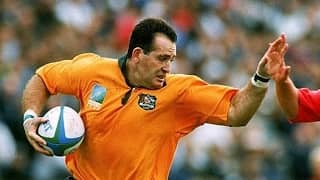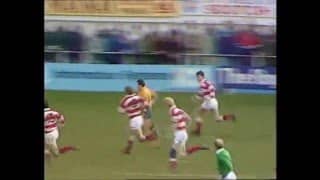Earlier this month, veteran Sunday Times rugby writer Stephen Jones unveiled his picks of the greatest rugby players he had ever seen. It was a selection that, shall we say, didn’t meet with universal acclaim.
Here is Jones’s much-derided selection:
15. Chris Latham (Australia)
14. Gerald Davies (Wales)
13. Jeremy Guscott (England)
12. Frank Bunce (New Zealand)
11. David Campese (Australia)
10. Juan Martin Hernandez (Argentina)
9. Gareth Edwards (Wales)
8. Sergio Parisse (Italy)
7. Sam Warburton (Wales)
6. Dan Lydiate (Wales)
5. Patricio Albacete (Argentina)
4. Simon Shaw (England)
3. Olo Brown (New Zealand)
2. Mario Ledesma (Argentina)
1. Garry Pagel (South Africa)
To say there were some bizarre choices would be an understatement. But being the fine writer that he is, Jones explained away his choices well, leaving you almost convinced.
But many punters across the various rugby forums and websites were not. One, for example, called the selection laughable.
New Zealanders, especially, were bemused but resigned to it; as this was Jones at his usual Kiwi-baiting best.
The multiple award-winning writer of books such as the brilliant Endless Winter seems to reserve his best form for New Zealanders, whether downgrading their achievements and not giving New Zealand rugby credit its due, mocking their fans, or likening a visit to New Zealand to being in 1950s England.
For his latest stab, Jones picked only two Kiwis in his “greatest ever” XV: tighthead prop Olo Brown (no problem there) and Frank Bunce — whom Jones picked at inside centre, a position he didn’t usually play.
Ignored were decent choices such Richie McCaw, Dan Carter, Jonah Lomu, Christian Cullen and Zinzan Brooke — players who would make most people’s lists.
We grant that there will always be disputes with this kind of subjective parlour game. But we found at least five of Jones’s selections outright bizarre: Latham, Hernandez, Lydiate, Albacete and Pagel. Good players all, but best players ever?
Perhaps Jones should have just said that these were his favourite 15 players. In which case, no one could quibble with whomever he had named.
So in that light, here are the rugby XV players that we think are the best in their position and whom we have also most enjoyed watching.
To make things easier, we have not picked anyone still playing, even at club level. A few current players running around could one day supplant the men named below, but maybe not.
1. Os Du Randt (South Africa)
Nothing says ‘rugby prop’ more than this man.
He may be unfairly remembered in some circles for being bowled over by centre Scott Gibbs in the British Lions tour of South Africa in 1997. But the Ox is one of the few men to have won two World Cups — and the only one to win them 12 years apart (1995 and 2007).
Du Randt was a true scrummaging powerhouse who could also motor when required, as this highlights package shows:
Close second: Jason Leonard (England). Future contender/s: Gethin Jenkins (Wales), Cian Healey (Ireland).
2. Uli Schmidt (South Africa)
A mobile, skillful and powerful hooker, Schmidt was the inspiration and prototype for the likes of Sean Fitzpatrick, Schalk Brits and Jamie George.
Way ahead of his rivals at his time, it’s a damnable pity we didn’t get to see more of him at international level because of South Africa’s ban over apartheid.
Close second: Keith Wood (Ire). Future contender/s: Dane Coles (NZ), Malcolm Marx (SA).
3. Olo Brown (NZ)
No quibble with Jones here: the Samoan-born Brown was a real scrum technician and cornerstone, but not out of place in open play either.
Brown was probably one of the lowest-profile top-level rugby players in history, as he was extremely reclusive and shunned publicity.
Apparently a chartered accountant and lawyer in real life, but who can be sure? He is one of those rare individuals who has no google footprint. Try googling him – everyone’s just quoting one another over what little information there is of him. Guess no biography forthcoming.
A rare highlight:
Close second: Patricio Noriega (Aus). Future contender/s: Tadhg Furlong (Ire).
4. Martin Johnson (England)
A real behemoth at the front of the lineout. Though some may remember him for the one rare lineout he didn’t win for the Lions against Australia in 2001.
He was also tough all around and would make a good captain, as he never took a backward step.
Close second: Andy Haden (NZ). Future contender/s: Maro Itoje (Eng), James Ryan (Ire).
5. Gary Whetton (NZ)
Very mobile and athletic for a lock. Especially in his day when locks his size didn’t run around at full gallop as much.
Captained the All Blacks to the 1991 World Cup but seems to have been forgotten now as he was unfortunate to have fallen between two famous skippers in Wayne Shelford and Sean Fitzpatrick.
Close second: John Eales (Australia). Future contender/s: Brodie Retallick (NZ).
6. Abdelatif Benazzi (France)
Magnificent athlete and strong as an ox, Benazzi played for both his native Morocco and for France, with whom he won two Grand Slams and played in three World Cups.
In the 1995 semifinal, he was famously denied what looked like a legitimate try that would have won France the game and knocked out eventual champions South Africa:
Abdelatif Benazzi’s denied try
However, he did help knock out the All Blacks in that titanic semifinal four years later, and played a crucial role in “the try from the end of the earth” — the last time New Zealand lost at Eden Park (that’s him at the 25-second mark bamboozling a young Jonah Lomu and passing on to winger Emile Ntamack):
Close second: Andre Venter (SA). Future contender/s: Schalk Berger (SA); Jerome Kaino (NZ)
7. Michael Jones (NZ)
The most athletic and skillful openside flanker we have ever seen, with the hands and running ability of an outside back but with the lineout prowess and close-quarters-combat talents to match.
Jones scored the opening individual tries at the first two Rugby World Cups, as well as the opening try of the 1987 final. He lost some of his pace when he badly injured his knee in 1989, but made the switch to the blindside and was instrumental in the All Blacks’ first-ever series win in South Africa, in 1996.
Richie McCaw has many admirable qualities that made him a great All Black but Jones, we believe, trumped him as a rugby player.
Close second: Richie McCaw (NZ). Future contender/s: David Pocock (Aus).
8. Zinzan Brooke (NZ)
We first saw him at the Hong Kong Sevens in 1986, when he played alongside Wayne Shelford and Mark Brooke-Cowden in the forwards as NZ swept all before them to win the title for the first time.
His range of skills led to one UK journalist describing him as a rugby player with “the physique of a Greek god and the sidestep of Barry John“.
But Brooke was much more than a rugby sevens player, of course. He could run, tackle and pass, and even drop-kick goals in World Cup semifinals. His form led to the controversial dropping of Wayne Shelford from the All Blacks.
Close second: Murray Mexted (NZ). Future contender/s: Kieran Read (NZ); Sergio Parisse (Italy), Louis Picamoles (France).
9. Nick Farr-Jones (Australia)
Farr-Jones isn’t remembered for possessing the longest pass, the fastest delivery or the best running game. But the 1991 World Cup-winning captain was an outstanding all-rounder.
What we liked most about watching Farr-Jones play was his decision-making: he almost never took the wrong option, and kept all the cogs around him moving at their perfect rates. Had wonderful combinations with successive Wallabies flyhalves, Mark Ella and Michael Lynagh.
Close second: Joost van der Westhuizen (SA). Future contender/s: Conor Murray (Ire); Aaron Smith (NZ).
10. Mark Ella (Australia)
As with most people of a certain age, we had only a limited window to watch Mark Ella play.
Despite being at the top of his game, Ella retired from international rugby at only 25. But there is still ample footage to enjoy, and to be amazed and fascinated by.
He, more than anyone, was the modern embodiment of “flat back-line” play and was the lynchpin of the brilliant Randwick and Wallabies backplay of the 1980s under Bob Dwyer.
His brilliance was never more well encapsulated than in this video:
Close second: Stephen Larkham (Aus). Future contender/s: Dan Carter (NZ); Jonny Sexton (Ire).
11. Jonah Lomu (NZ)
For some reason, people choose to remember Jonah Lomu’s weaknesses and overlook or downgrade his strengths.
Lomu, while being a giant on the wing in the days before they became commonplace, also displayed skills that were often underestimated.
Lomu wasn’t just a battering ram, though he could batter away when called for.
Instead, he glided rather than sprinted over the field and had a beautiful swerve he used to great effect. He had a basic sidestep that wasn’t hard to read but which few opponents could do anything about.
Very few players could make it onto many people’s lists of the best rugby XVs and rugby 7s players of all time. But Mark Ella would have been one, and Jonah was definitely another.
Close second: Rupeni Caucau (Fiji). Future contender/s: Reiko Ioane (NZ), Jason Stockdale (Ire); George North (Wales).
12. Tim Horan (Australia)
Smart, sharp and skillful, the Aussie nicknamed ‘Helmet’ was the complete package. He could even play flyhalf at a pinch, though the less said about that experiment the better.
Tim Horan was outstanding when Australia won the World Cup in 1991, not quite at his best after a horrendous knee injury before the 1995 RWC, and played through illness to help Australia win again in 1999.
Close second: Yannick Jauzion (France). Future contender/s: Ma’a Nonu (NZ);
13. Danie Gerber (South Africa)
Fast, powerful and a wonderful sight to behold.
Unfortunately, as with Uli Schmidt, the world missed out on seeing the best of Gerber because of the ban on sporting contacts with apartheid South Africa.
After the ban was lifted, the Springboks hosted both Australia and New Zealand in 1992. But by then, Danie Gerber was past his best and was bettered by both Wallaby Tim Horan, and All Black Frank Bunce.
But he was outstanding on the 1981 tour of New Zealand and on the few occasions the Springboks played international rugby in the 1980s.
This video shows Gerber at his best. It is about half-an-hour long but definitely worth watching, especially for the mid-80s games (19th minute mark), when he carved up the New Zealand Cavaliers (an All Blacks team in all but name; many of the same group won the first Rugby World Cup the following year) and the Five Nations XV.
Close second: Brian O’Driscoll (Ire)/Philippe Sella (Fra). Future contender/s: Conrad Smith (NZ), Semi Radradra (Fiji)
14. David Campese (Australia)
David Campese is another who would make the list of players who were world-class rugby players at 7s and XVs.
At his best, Campese was one of a kind. Blinding pace, inspired running, superb vision, gifted hands.
But again, detractors like to pick at his defence, which was not great but more than adequate; and his mistakes, especially against the British Lions in 1989.
But he was an absolute joy to watch and didn’t go hiding but instead came up with winners when required.
Here are two compilations worth watching:
Close second: John Kirwan (NZ)/Ray Mordt. Future contender/s: Ben Smith (NZ).
15. Serge Blanco (France)
A sheer delight to watch, the Venezuelan-born “Bomber from Biarritz” was most people’s favourite fullback and the epitome of elegance, flair, skill and speed.
Twice a Grand Slam winner with France, Blanco was also famous for being a chain smoker whose form dropped off significantly one year when he tried to quit smoking.
He still holds the record for most tries for France, one of the most famous of which broke Australian hearts in their famous last-minute win over the Wallabies in the 1987 World Cup semifinal (10’35” mark in the video below).
Close second: Christian Cullen (NZ). Future contender/s: Israel Folau (Aus).
Great rugby sevens players too
In an age when rugby sevens and XVs are seen by some as two different sports, we would argue that if you’re a great rugby player, you can play both sevens and XVs.
While we concede there are many XVs players who weren’t very good at sevens, and vice versa, some of the best players that have ever played rugby would make a nonsense of the argument that sevens is now a game for specialists only.
Indeed, you could select a great sevens team from the players above that would give any sevens team running around in the World Sevens Series today more than a run for their money.
Our picks would be:
Forwards: Lomu, Venter, Brooke
Link: van der Westhuizen
Backs: Ella, Campese, Cullen.
Reserves: Jones, Farr-Jones, Horan.




Some good picks there, but the newest player named is Os Du Randt. You sure there are no other newer ones? How about Victor Matfield or Bryan Habana or Jean Devilliers, just to name the South Africans.
I did consider those players but Matfield lost out to Whetton and Eales.
While Matfield was excellent, he played largely in an era when lifting in the lineout became allowed, which can make your lineout prowess more pronounced.
Whetton played in the days when lineouts were also known as “dockyard brawls” and he excelled nevertheless.
Eales played in both eras and was a World Cup champion in both. He could also kick conversions and penalties nervelessly and pull off try-saving tackles. He was practically perfect, hence his nickname of “Nobody” (as in nobody’s perfect).
But Whetton was a bit more exciting to watch around the field.
Habana was speed personified but didn’t thrill me otherwise. There was not that much more to his game, unlike Lomu or even Caucau.
De Villiers was an excellent stalwart for the Springbok but again, he was not that exciting a player to watch, unlike Horan or even France’s Yannick Jauzion.
As for other more recent players, I did consider them all, but stand by my final choices — i just think they were better in every way.
Good selection but should probably have more who played in the professional era.
If you have any in mind, feel free to suggest them. We’d love to check them out.
See the Saffas I suggested above. Plus Jonny Wilkinson, Jason Robinson, Will Greenwood (all England); Stephen Larkham, Joe Roff, Andrew Walker (all Australia); Brian O’Driscoll (Ireland); Carlos Spencer, Joe Rockokoco, Brad Thorn. These are all players from the pro era who have retired and fit your brief.
Thanks for your suggestions.
All note-worthy players, I grant you. Jonny was definitely an outlier of his generation but to be frank, I did not enjoy watching him as much as Ella or Larkham or even Dan Carter.
And we did consider professional-era players — Cullen, Caucau, Jauzion, Larkham etc — and some were even pretty recent, such as O’Driscoll and McCaw.
But I do believe the players chosen have been the best players for their position. And the best to watch. — Lomu, Horan, Campese, Ella etc are very hard to beat by any measure.
Among the players still playing, there are a few who will probably be considered the GOAT in their position so you might as well put them in now!
I’m thinking: Brodie Rettalick, Dan Carter, Maa Nonu, Tadhg Furlong, Malcolm Marx, David Pocock,
Yes, Retallick will probably be better than the two locks on the list but let’s see him maintain his form for his whole career. There have been players who faded away despite a very good first 4-5 year of their career.
Carter I may update when he retires – who knows; Barrett or Sexton may well prove better in the next few years.
The same goes with the others on the list. Furlong is outstanding but Marx I find inconsistent, while Pocock is superior in one aspect of flanker play but not outstanding in others.
This site has really made the best selection of the rugby players.I really loved watching Os Du Randy play back then in 2006,although I didn’t get to watch most of these great players but after I became interested in rugby in 2005 back then I’ve made research and I’ve been coming across this names.
Os Du Randt was indeed a great player to watch. And to win two Rugby World Cups so many years apart shows he was a top player over a long period. Hope you continue to enjoy watching the game.
Great to learn about sport of rugby. I don’t play the game actively and the game is just getting popular in Nigeria. I’m not familiar with those legends you mentioned there but I know how big rugby is in South Africa, England, New Zealand, Australia. Nigeria is building some great players playing rugby their coach is from South Africa.
Have learned a lot from your article. Thanks
There have been many good players of Nigerian descent who have played for other countries, especially England. I look forward to seeing a good Nigerian rugby team!
Great Article and points well raised,
At first glance there was a glaring omission of the England 2003 World Cup winning team, I note you have included Martin Johnson in your list of omitted players but Johnny Wilkinson also deserves a mention who was probably the greatest kicker under pressure there has ever been who always lead from the front.
I also agree how Jonah Lomu can be omitted given the impact he had on making rugby a global name in the 1990’s is barbaric.
Jonny Wilkinson was a world-class kicker, in a league of his own, and a world-class defender but he was limited in other aspects of play that I value higher, such as running the ball and controlling the play. The players I have picked were thrilling to watch and could do things few others could.
Wilkinson was a great kicker and defender but not the most exciting player in the world. Decent passer and runner but probably wouldn’t rate among the top 50 flyhalves in history in those areas of the game.
Wow, that’s a big call. Top 50!? You’re a hard marker.
I can name at least 10 flyhalves, as top talented rugby players exciting to watch, that I would pick over him; but I would have put Wilkinson at least in my Top 20.
But you could be right. I’ll have a think.
Pretty good insight on rugby players, some of these people I haven’t even heard of. I like being able to look for new players in all sports to keep an eye on in the future. Even though this is more of a hall of fame, that makes it even better. Watching old games and seeing players in their prime is always a good sight to see, especially when they have a passion for it.
We must never forget our greats. Be it music, literature. True talent transcends the passing of the times. And sports, and in this instance rugby union, has its share of greats that were great then and are still great now.
Luckily, we have videos that can bring the past’s greats to our living room, on demand!